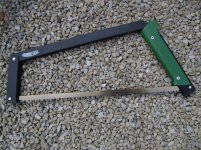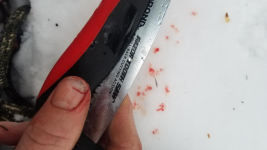Many years ago, I learned a lesson about hatchet safety the hard way. No blood was spilled, but a tiny chip of wood was launched by my hatchet's impact and shot into my eye. I should have known better, coming from my background of industrial use of impact tools. Henceforth, due to the proximity of face to short handled hatchets, I won't use one without eye protection.
-
Happy Winter Solstice! 🌇🌃
You are using an out of date browser. It may not display this or other websites correctly.
You should upgrade or use an alternative browser.
You should upgrade or use an alternative browser.
Hatchet or Saw?
- Thread starter Black_Fly
- Start date
I don't carry either/or... it's always both or none. I have various combinations for various means of transport and portage difficulty. When backpacking, I seldom carry either, as I'll generally be WAY deep, and then it's easy to find good firewood that doesn't need cutting and splitting, just hand processing with a small knife to split if you absolutely have to. I also have a few favored sites where I've stashed a small folding saw/hatchet combo most of the way in, so I don't have to carry them in/out every time.
For saws, I have a full size 32" bow saw, 24" folding bucksaw, Agawa Canyon Boreal 21, Sven 15, and Silky Gomboy and Pocketboy (~2lbs down to 8oz or thereabouts.)
For hatchets/hawks/axes, I have about 9, I think, and they go from 5lbs down to 12oz.
For saws, I have a full size 32" bow saw, 24" folding bucksaw, Agawa Canyon Boreal 21, Sven 15, and Silky Gomboy and Pocketboy (~2lbs down to 8oz or thereabouts.)
For hatchets/hawks/axes, I have about 9, I think, and they go from 5lbs down to 12oz.
I've carried a full ax, a hatchet, a 4 lb Estwing maul (Fireside Friend), an 18" Corona pruning saw, and a 10" Corona folding pruning saw. We occasionally use a fire to cook with the Dutch oven, but usually any fire is for ambiance. The 10" Corona has been more than good enough to easily provide us with usable wood, so that's the one must-bring cutting tool that we carry. It's also the lightest option and since it locks closed with the blade in the handle, I have no problem carrying it in my pack next to my tent and sleeping bag.
The other piece of essential gear: a blow rod to accelerate the fire. My brother's is fixed-length aluminum rod with a wooden mouthpiece/handle and second handle. I've seen pocket bellows, but not used them.
The other piece of essential gear: a blow rod to accelerate the fire. My brother's is fixed-length aluminum rod with a wooden mouthpiece/handle and second handle. I've seen pocket bellows, but not used them.
I found an extendable magnet at the dollar store, on a similar 'tube', took off the magnet and worked a bit on smoothing the end so it doesn't cut and doesn't get pushed in too far, and it works fine at 1/16th the price. I agree; well worth carrying.The other piece of essential gear: a blow rod to accelerate the fire. My brother's is fixed-length aluminum rod with a wooden mouthpiece/handle and second handle. I've seen pocket bellows, but not used them.
Neither. I have a collection of axes, broad axes, adzes and other wood working tools. But now I take blood thinners and the risk is too high for using those tools. Decent fire wood is old and dead. If it doesn't break easily I just put one end in the fire and keep pushing.
I do occasionally use a chain saw with protective equipment, but only in the yard not in the bush. I used to be in the logging business a long time ago.
I do occasionally use a chain saw with protective equipment, but only in the yard not in the bush. I used to be in the logging business a long time ago.
Thanks Robin, it looked like it. I used to have a slightly smaller Hudson’s Bay axe that I got from LL Bean back in the ‘70’s I lost that in the divorce. The one I have now looks the same as yours Robin. I’ve almost always brought both, saw and small axe. Never brought a hatchet but I have several that I use around the house/yard all the time.
Jim
Jim
Kahel, have you thought about joining axe-aholics anonymous?
I’ve never carried an ax in a canoe. Saws, pruners, loppers, yes. Of late, electric, mini chain saws. But never an ax. I did once take a splitting mail to Assateague, but only because I knew NPS had done storm cleanup and left at the campsites large rounds of pine.
I’ve never carried an ax in a canoe. Saws, pruners, loppers, yes. Of late, electric, mini chain saws. But never an ax. I did once take a splitting mail to Assateague, but only because I knew NPS had done storm cleanup and left at the campsites large rounds of pine.
Last edited:
On the subject of injury potential, I don't often actually swing my 14" hatchet. I'll do so if I'm stripping branches off a log, but only with consideration about my body positioning to keep away from my swing path and deflections. The hatchet is primarily used as a wedge, one that happens to have a convenient handle. For splitting short lengths of wood, I'll stand them on end, lightly engage the hatchet blade on top, and then use another piece of wood as a mallet, striking the backside of the hatchet head. This is pretty efficient for processing small pieces of wood for my relatively small tent stove. I do the entire process comfortably on my knees, so the blade hardly moves more than a few inches and relatively slowly. And I'd more likely bury the blade into the ground than my foot.
I'll also confess that my Fiskers hatchet isn't too precious and has probably been subjected to the occasional rock blow, when a rock happens to be the requisite mass available within arm's reach but wood certainly makes for a better mallet.
I'll also confess that my Fiskers hatchet isn't too precious and has probably been subjected to the occasional rock blow, when a rock happens to be the requisite mass available within arm's reach but wood certainly makes for a better mallet.
Last edited:
Stopped carrying an axe long ago. Just never processed wood that necessitated that capacity. I carry a ka-bar knife. Still small enough to use for knife stuff but beefy enough for light chopping and batoning down bigger sticks.
Always bring a saw for safety. If I don’t it’s too tempting to do something dangerously stupid like attempting to break a large stick with your knee or something. I currently have the Agawa Boreal 21. Awesome saw but that too is really kind of big for what I need. I just make small campfires, not bon fires. Will probably pick up an Agawa Boreal 15 at Canoecopia next March.
Always bring a saw for safety. If I don’t it’s too tempting to do something dangerously stupid like attempting to break a large stick with your knee or something. I currently have the Agawa Boreal 21. Awesome saw but that too is really kind of big for what I need. I just make small campfires, not bon fires. Will probably pick up an Agawa Boreal 15 at Canoecopia next March.
For splitting short lengths of wood, I'll stand them on end, lightly engage the hatchet blade on top, and then use another piece of wood as a mallet, striking the backside of the hatchet head.
This is a safe way to use a hatchet and is effective. Tap splitting firewood with a baton can also be done effectively with a good knife or machete, either of which I prefer to a heavier, less versatile and more dangerous (to me) hatchet for a simple canoe trip. Along with a good pruning saw.
If I'm car camping and/or it's a big, comfortable camp then I will use an ax for chopping firewood. If I'm traveling light then I prefer a small stick fire and I'll carry a commando saw as a backup.
When splitting wood with an ax I do it on my knees, that way the ax will hit the ground and not my legs if I miss.
When splitting wood with an ax I do it on my knees, that way the ax will hit the ground and not my legs if I miss.
Currently I'm taking an Agawa Canyon ADK26 and Boreal21 along with a Black River 3.75" Fixed Blade for batoning. I've found that this kit allows me to do pretty much anything I need to process wood.
Based on the collective recommendations above (@Blukanu, @Glenn MacGrady, @TrailBlaser), I’m going to experiment with a knife and baton, and plan to leave the hatchet at home for my next solo trip.
I think the hatchet will still go in the fire cook box for group trips. I read something interesting in Gil Gilpatrick’s book recently, and I’m paraphrasing, but he said that there’s always an enthusiastic push for firewood when a group first arrives at camp, an enthusiasm that quickly fades, so you better have enough tools at hand to accommodate all that enthusiasm when you have it, or the processing will fall to you later.
I think the hatchet will still go in the fire cook box for group trips. I read something interesting in Gil Gilpatrick’s book recently, and I’m paraphrasing, but he said that there’s always an enthusiastic push for firewood when a group first arrives at camp, an enthusiasm that quickly fades, so you better have enough tools at hand to accommodate all that enthusiasm when you have it, or the processing will fall to you later.
Historically I did more solo tripping in the ADKs and Algonquin, and as such have never carried an axe / hatchet (too heavy plus potentially dangerous). But lately I have been tripping with others on river trips without portaging, and am debating bringing a hatchet. Does anyone have experience with the Adler "The Canoe" axe? I have been searching forums and have found nothing - by name alone it is of interest of couse! Would love to hear about experiences with this (or similar) hatchets...
Historically I did more solo tripping in the ADKs and Algonquin, and as such have never carried an axe / hatchet (too heavy plus potentially dangerous). But lately I have been tripping with others on river trips without portaging, and am debating bringing a hatchet. Does anyone have experience with the Adler "The Canoe" axe? I have been searching forums and have found nothing - by name alone it is of interest of couse! Would love to hear about experiences with this (or similar) hatchets...
No experience with it, but I like the looks of it.
I like to carry a Silky pocketboy and an Alder scout axe. Both are effective, efficient tools and they do not take up much space, nor weigh very much.
Similar threads
- Replies
- 23
- Views
- 1K
- Replies
- 17
- Views
- 4K



















